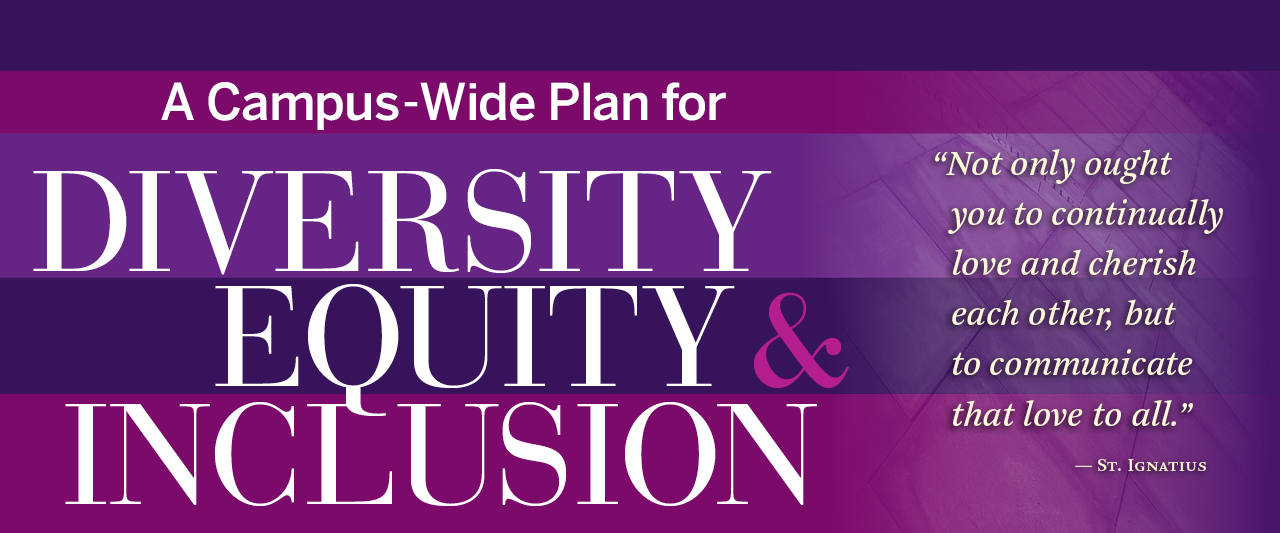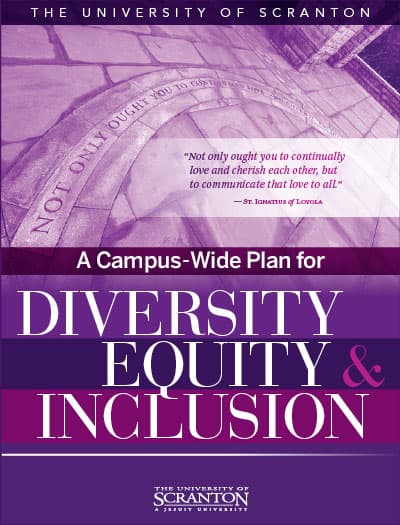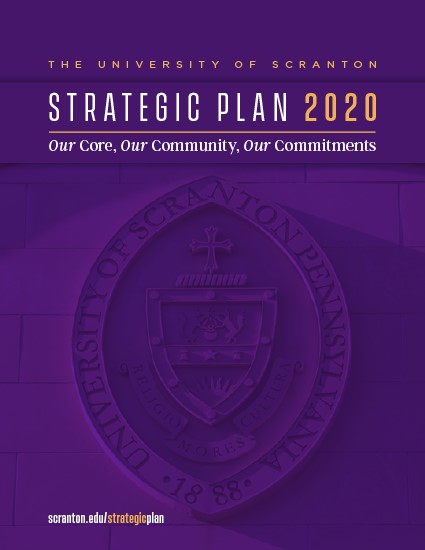Introduction
The University of Scranton is committed to diversity, equity, and inclusion, recognizing it as an integral aspect of our Catholic and Jesuit identity, mission, and tradition. The University strives to frame its mission, strategy and policies within the body of Catholic Social Teaching, that deep and profound collection of teachings that calls us to recognize the dignity of each and every human person, to work together in building a truly just society, and to live lives of faith, hope and love. In doing so, the University participates in the life and mission of the Church for the purpose of having an authentic impact on all those it serves and who comprise its community.
But, as Pope Francis pointed out in his encyclical letter Fratelli Tutti (2020), “goodness, together with love, justice and solidarity, are not achieved once and for all; they have to be realized each day. It is not possible to settle for what was achieved in the past and complacently enjoy it, as if we could somehow disregard the fact that many of our brothers and sisters still endure situations that cry out for our attention.” Put another way, the vision described by the Pontifical Commission (above), is an ongoing project and a human effort aided by grace.
As we present this strategic plan for Diversity, Equity and Inclusion, it is our intention and hope to remain focused on the tenets of Catholic Social Teaching as a source of inspiration for creating and fostering a truly inclusive community, thereby advancing our shared mission for generations to come.
Foundation: The University's Strategic Plan
The University’s 2020 Strategic Plan includes the following institutional goal for diversity and inclusion:
Diversity and Inclusion: Reflect and understand the diversity of the world by demanding that diversity be a priority as we build an inclusive community and campus culture, develop and deliver our education and shape our student experience.
This goal and its five supporting objectives provide a broad, foundational framework for diversity and inclusion efforts in the years to come. The Diversity and Inclusion Plan presented here describes concrete, operational actions we will undertake to achieve them. This document, and the work undertaken to produce and implement it, addresses the first of the Strategic Plan’s objectives: Implement an institutional plan for diversity and inclusion, drawing from a comprehensive review of University departments, organizations, spaces, and processes that provide and support inclusion and diversity-related education and programming, ensuring that these collaborative efforts are appropriately aligned and effectively resourced.
Taken together, both levels of planning – the strategic, and the operational - address in increasing specificity recommendations and needs identified from campus-wide assessments, including, but not limited to findings and recommendations from the 2019 Middle States Self-Study; 2018 Mission Priority Examen; data from institutional and student surveys that were considered as part of both studies; the 2019 Strategic Enrollment Planning process; and, most recently, the Fall 2020 HEDS Diversity and Equity Campus Needs Assessment Survey. Comments, suggestions and recommendations gathered through campus-wide listening sessions and survey opportunities during the Strategic Plan’s development were also reconsidered as part of this analysis.
Building and Sustaining the Campus Plan for Diversity and Inclusion
The Diversity and Inclusion Planning Team was assembled to construct and propose a Diversity and Inclusion plan, considering assessment findings, current campus activities, emerging programming and initiatives, best practices and examples of work from other peer institutions.
The Team is composed of members of the University Planning Committee, the Provost’s Council for Diversity and Inclusion1, representatives appointed by the faculty, staff, and student senates, and other faculty and administrators with experience and expertise in key areas.
The Team followed a phased plan of work over intersession, spring, and summer. Team members divided into five smaller working groups examining diversity and inclusion in: Student Life Activities, Initiatives, and Programming; Faculty and Staff Experience; Academic Life & Curriculum; Alumni and Community Experience; and Admissions; and Student Recruitment, Retention and Enrollment Management. In addition to campus resource and external best practice review, members of these groups met with a variety of individuals on campus.
- Phase 1 – Review of existing and emerging University activity and assessments, campus interviews, and peer practices
- Phase 2 – Summary of research findings, initial recommendations for action
- Phase 3 – Drafting of initial Team report and campus-wide action plan for Diversity and Inclusion
- Phase 4 – Review, Feedback to Team findings, draft plan throughout the campus community, and add additional stakeholders to the process
- Phase 5 – Formation of planning oversight and implementation process, including prioritization activities, processes and responsibility for outcomes reporting and assessment of growth, and plan ongoing renewal
- Phase 6 – Operationalization, Progress Monitoring, and assessment of growth.
The Team recognizes the need for these steps to be a continuous process, and the resulting plan should be a living document, one that is open to change informed by assessment. Team discussion of what was learned in Phases 1 through 3 suggest the following overarching goals for diversity and inclusion planning as an intentional process. Evaluation of the extent to which they are being realized may help us monitor the degree of transformational growth in this area:
- Articulate and implement concrete action steps and phased priorities to achieve our Strategic Plan’s goal and objectives for diversity and inclusion.
- Promote education and action on diversity, inclusion, and equity and their place in our mission, identity, and institutional history, and establishing clear expectations for supporting initiatives in all areas of University life.
- Grow and sustain an educational and scholarly commitment to diversity and inclusion in academic and co-curricular areas.
- Establish an appropriate structure for diversity and inclusion that has the authority and ability to align services, programs, and units in shared support of our diversity and inclusion goals, and a mechanism to celebrate and assess the work being done.
- Transform our University community through intentional and integrated planning, assessment, honest reflection and transparency, establishing clear areas of responsibility, accountability, and avenues for reporting.
Learn about Plan Stewardship and Sustainability








